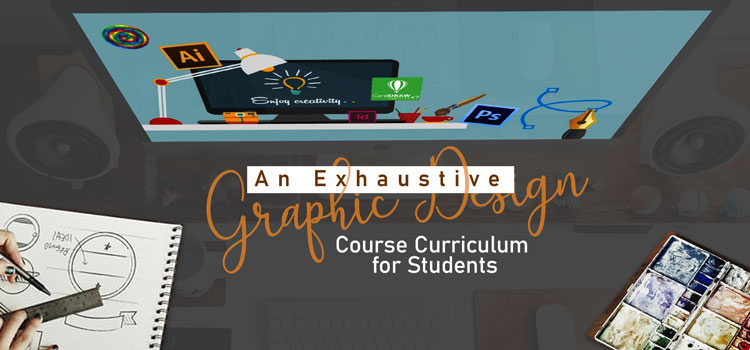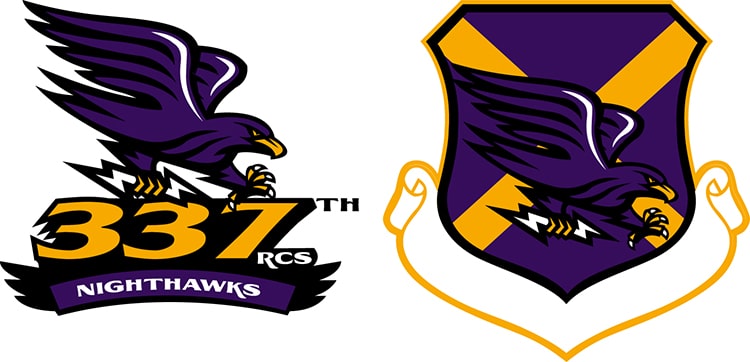An Exhaustive Graphic Design Course Curriculum for Students

Graphic design course curriculum for students
Looking for a comprehensive guide on graphic design course curriculum? If yes, then this article is for you. If you are looking for a subject to study in order to have a flourishing career, graphic design is definitely the one you can opt for. Graphic design is an extensive field and it is evolving every day. The objective of design is to make fruitful modifications in social organizations. With the introduction of new technology, graphic designers are polishing their skills and techniques. They make use of their design knack and knowledge in web design, artwork, logo design, book, magazine, poster, computer games, billboard advertising, packaging, illustration, animation, corporate identity design, editorial design, etc.
What is meant by Graphic Design?
Graphic design denotes the use of pictures, symbols, and even texts to attain a particular purpose or solve a particular problem. It is a craft of producing visual content to communicate messages. With the application of page layout techniques and visual hierarchy, graphic designers integrate texts, shapes, lines, colors, textures as well as other symbols considering the user needs and create eye-catching designs for optimized user experience.

Graphic design is not a walk in the park rather it’s an uphill task. It’s not limited to certain techniques that one can learn and become a deft graphic designer. It has various types and each of them requires a different set of skills and specializations even though these types overlap with one another. As a graphic designer, you have to groom yourself in such a way so that you can acclimatize yourself in any design category while building your career.
Graphic Design Course Curriculum for Students
Module 1: Introduction to Graphic Design: This module is a cracking one for the students to know what graphic design is and how graphic designers work. It sheds light on the professional opportunities that the students can after they complete their study. By going through this book, they can know the masterpieces accomplished by eminent past and present graphic designers. They will get familiar with the popular graphic design sites embodying works belonging to different industries for which graphic designers worked.
Module 2: Design Basics: With the help of this module, students will learn how to implement design elements and principles. Students will initiate making decisions using the visual language of a graphic designer. On top of that, the module will also introduce the students with the vector-based software Adobe Illustrator.
Module 3: Introduction to Typography: Typography is an ineluctable tool for the graphic designers to avail in their design process. This particular module will impart them conducive knowledge and information about typography. They can know the pivotal role of typography in graphic design. In this module, they will learn the history and evolution of typographic design.
Module 4: Colour: In this module, students will get the opportunity to learn about the principles and intricate elements of color that produce incredible designs. The module will impart them the vocabulary and tools required to create a variety of color designs. The module is so exhaustive that they can garner working knowledge of color designs by doing in-depth studies.
Module 5: Advanced Typography: This is an advanced level module and is thoroughly computer-based. It will help them advance their knowledge of typography. They will know how to employ graphic design elements in the typographic designs. This module is also so comprehensive that they can notch up practical knowledge of typography by doing profound studies.
Module 6: Photography: Module 6 will provide an overview on the concept of photography. They can learn about various photography tools that are required to snap photos as a graphic designer. They will attain knowledge about how graphic designers collaborate with photographers. The module is a crack one to impart students the tactic of sourcing online stock photos. They will get introduced to the pixel-based photo editing software Adobe Photoshop.
Module 7: Logotype Design: This module will assist the students to be creative. In this module, they will utilize the tools that they have learned create typographic systems. This is how they will make dynamic logotypes. On top of that, they will learn to create evident, well-crafted, and meaningful word-marks by manipulating the letterforms.
Module 8: Design Systems 1: This one is all about systems and under this module, students will show expertise for design principles as they can create graphical interpretations of the organic subjects. This project strengthens the creative process and enables the students to use Adobe Illustrator to develop their skills. They will conceptualize and polish their design systems based on the organic form of their choices.
Module 9: Layout Design: In this module, the students will pick up indispensable knowledge on composition and layout design. They will produce dynamic typographic compositions in multi-page layout program, Adobe InDesign. Students will bolster their vocabulary that they learned in the earlier module pertaining to typographic layout.
Module 10: Design Systems 2: At this stage, students will have tons of knowledge about graphic design and they will be able to make their own decisions to produce masterpieces. They already learned about Adobe Photoshop as well as InDesign and are fully aware of the strengths and weaknesses of these types of software. They will also be able to explore and brainstorm various graphic design projects. The module will also enable the students to review their previous projects and refine them, thereby preparing their first graphic design portfolio.
Module 11: Preparing your Portfolio: Stepping into module 11, students will get the opportunity to promote their projects. They will begin to polish their portfolio and create their professional identities. The module will be an excellent platform for them to master basic professional graphic design practices and develop their design education.
Module 12: A terrific opportunity for the students to receive feedback on the projects accomplished in module 11 and rectify the errors. In this module, they will prepare a resume and cover letter availing their design knack based on their professional identity. They will get the advantage of having industry consultation on some of their curated works.
Career Paths for Graphic Designers:
Graphic design is a cracking subject to subject as it offers a diverse range of career opportunities for the graduates to pursue. Just because you studied graphic, the design doesn’t mean you can only be a graphic designer. In fact, it can lead you astoundingly to tons of other job opportunities. Design career is so extensive that you can make use of your craft and education to some of the lucrative positions. If you aspire to work for a company, you can work for an advertising agency, publishing agency, photo editing company, industrial design firm, and many other industries. However, if you have the potential to become your own boss, that is to become an entrepreneur, you can also go for it utilizing your talent and skill. On top of that, you can work as a freelancer as well.
- Graphic Designer: An entry-level graphic designer functions under a seasoned graphic designer and predominantly aids in designing projects like print ads, website banners, and original arts for products. With some experience under one’s belt, a graphic designer designs graphics and layouts for product illustrations, company logos, artworks, etc. Depending on the industry they work for, their range of responsibilities differ. They can also work as freelancers without following particular rules and regulations like how to work and when to work. That means, they can work following their own styles. However, there are some hurdles in working as a freelancer like seeking and landing clients, pitching works, managing finances, and also following tight deadlines.
- Art Director: Graphic designers can make their way to become art designers notching up some experience under their belt. Art designers basically produce designs for products, advertisements, marketing campaigns, and other innovative products. They undertake the visual content of newspapers, magazines, movies, television programs, product packaging etc. and lead their respective team. They closely collaborate with the clients to create artistic masterpiece taking into consideration the budget and demand of their clients.
- Creative Director: Creative director is another position that graphic designers can opt for after garnering considerable experience. Creative directors are mainly tasked with inter-departmental projects. A creative director is liable for the overall vision of a project, product, campaign, and company. He converts ideas into tangible and intangible design materials. Creative directors ensure the overall majestic look of various product designs. This job requires the aspiring professionals to boast leadership, budgeting and time management skill.
- Product Developer: Product developers are entrusted with a variety of tasks. They ideate, manage, lead, and create products. Even though they keep switching their responsibilities, their premier tasks embody doing industry-research, producing illustrations, putting forth products to the employers and stakeholders, contributing in the development process.
- Production Artist: Production artists are directly engaged with the hands-on creation of graphics, film, art, or other formats. They upload and make sure the perfection of various design files till the last stage of development. They also have the prerogative to propose any modification in various designs if required. On top of that, they also take the charge of scaling, cropping, processing, repositioning different designs as well as elements of designs.
- Multimedia Designer: A multimedia artist or designer possesses a wide range of skills in art, sound, and design to produce audio, video, art, and animated image. They develop some exceptional skills to create visual effects that will inform, entertain, and engage the audience. Their task encompasses designing props, costumes, and sets blending imagination with creativity in addition to their technical expertise on various multimedia software. They guide the set assistants on design methods and exhort them on technical production such as lighting and sound to make sure it aligns with their designs.
- 3D Designer: With an in-depth study on graphic design, a graphic designer can take up his career in 3D designing. Instead of choosing a career that embodies traditional skills, 3D designing enables a student to master in real-life design. Whether it’s an architectural design, character design, or product design, 3D designers can shape their designs that look like real buildings, characters, and products. They can be rotated three-dimensionally to view from all the angles. Among the products that they design, mobile, laptop, chair, table, sofa, bottle, etc. are noteworthy.
- Animator: With the rapid technological advancement, the demand of animation is escalating in the field of graphic design. An animator develops a story, creates visual splendors, and brings the images into life to satisfy the demand of the audience. A graphic designer craving to pursue his career in animation can work in movies and cartoons but they can also choose to work in advertising and graphic design companies to create advertisements, tutorials, and various types of animated banners.
Graphic design is a lucrative field not only in terms of building a flourishing career but also in terms of making money. This is one of the rare fields which is unlikely to be obsolete in the near future. The more you refine your skills and notch up experience, the more you will be sought-after to your clients. Whether you work as a freelancer or for any company, you can earn considerable bucks and standardize your lifestyle.
We anticipate that this article would assist you immensely before you make up your mind to study graphic design. We have not only incorporated the course curriculum but also supplemented the career path you can opt for after you accomplish your study. We are a graphic design and photo retouching company headquartered from USA. We are a specialist in the field of graphic design and image manipulation services. You can contact us anytime when you need our assistance. Visit our Facebook page for more information about us.







